
Platysteiridae is a family of small, stout passerine birds of the African tropics. The family contains the wattle-eyes, batises and shrike-flycatchers. They were previously classed as a subfamily of the Old World flycatchers, Muscicapidae. These insect-eating birds are usually found in open forests or bush. They hunt by flycatching, or by taking prey from the ground like a shrike. The nest is a small, neat cup, placed low in a tree or bush.

Batis is a genus of passerine birds in the wattle-eye family. Its species are resident in Africa south of the Sahara. They were previously classed as a subfamily of the Old World flycatcher family, Muscicapidae.
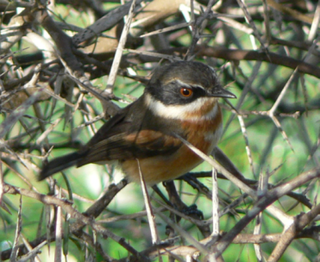
The Cape batis is a small, stout insect-eating passerine bird in the wattle-eye family. It is endemic to the Afromontane forests of southern Africa.
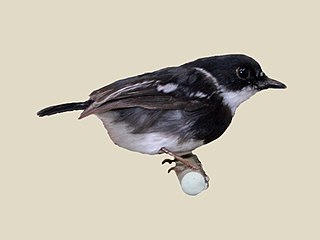
The Rwenzori batis is an endemic bird native to the Albertine Rift montane forests, where it inhabits altitudes of 1,340–3,300 m (4,400–10,830 ft).
The Ituri batis or Chapin's batis is a species of bird in the wattle-eye family, Platysteiridae which is found in the humid forests of eastern central Africa.

Margaret's batis or Boulton's batis, is a species of small passerine bird in the wattle-eyes family, Platysteiridae. It is found in south western central Africa.
The Gabon batis or Verreaux's batis, is a species of small bird in the family Platysteiridae. It occurs in the humid forests of western Central Africa.
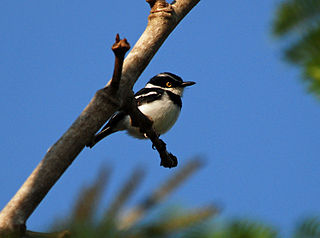
The eastern black-headed batis is a passerine bird in the family Platysteiridae from eastern Africa. It was formerly treated as conspecific with the western black-headed batis.

The Angola batis is a species of bird in the family Platysteiridae. It is found in western central Africa.

The forest batis or short-tailed batis is a species of bird in the wattle-eye family, Platysteiridae occurring in eastern Africa.
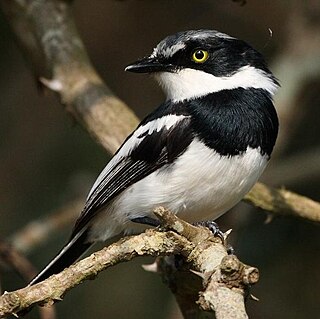
The chinspot batis is a small songbird of the genus Batis in the family Platysteiridae which is a common and widespread species in the woodlands of southern Africa from the Eastern Cape north to 3°N in southern Kenya and Gabon. It forms a superspecies with other rather similar members of the genus Batis.

The grey-headed batis is a species of bird in the wattle-eyes family, Platysteiridae, it was previously classified with the Old World flycatchers in the family Muscicapidae. It is found in eastern and central Africa.

The pygmy batis is a very small insectivorous bird which finds its food foraging among leaves, it is a member of the wattle-eyes family, the Platysteiridae. It occurs in the dry savannahs of north-eastern Africa.
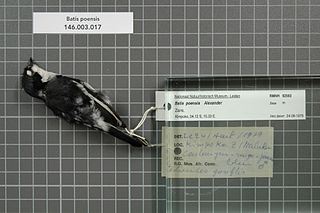
The Fernando Pó batis, also known as the Bioko batis, is a species of bird in the family Platysteiridae. It is endemic to the island of Bioko in Equatorial Guinea.

The Senegal batis is a species of small passerine bird in the wattle-eyes family, Platysteiridae. It occurs in western Africa where it is found in dry savanna and subtropical or tropical dry shrubland. It was originally given the binomial name Muscicapa senegalensis by Carl Linnaeus in 1766.

The pale batis, also known as the Mozambique batis or East coast batis is a species of small bird in the wattle-eyes family, Platysteiridae. It occurs in eastern Africa, mostly in lowland miombo woodland.

The marsh tchagra or blackcap bush-shrike is a species of passerine bird placed in the monotypic genus Bocagia in the family Malaconotidae. It is native to marshes in the tropics and subtropics of Africa. It is sometimes placed in the genus Tchagra.
The dark batis is a small passerine bird belonging to the genus Batis in the wattle-eye family, Platysteiridae. It is found in highland forest in south-west Tanzania, northern Malawi, and northern Mozambique. These birds were formerly thought to be forest batises but in 2006 were described as a new species based on differences in morphology and mitochondrial DNA from those birds in northern Tanzania and Kenya.

The Woodward brothers were Richard Blake Woodward and John Deverell Stewart Woodward, who were English missionaries and ornithologists. They were born in Bathford, England to Richard and Mary Woodward. Through their field expeditions, specimen collecting and publications, they, along with Arthur Stark, established a basis for 20th-century ornithology in the southern African region.

The western black-headed batis or Von Erlanger's batis, is a species of passerine bird in the wattle-eye family Platysteiridae. It is found over an extensive area of central Africa. Its natural habitats are subtropical or tropical dry forests and moist savanna. It was formerly treated as conspecific with the eastern black-headed batis.
















